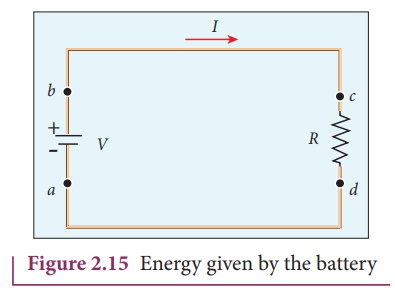Chapter: 12th Physics : Current Electricity
Energy and Power in Electrical Circuits
ENERGY AND POWER IN ELECTRICAL CIRCUITS
When a battery is
connected between the ends of a conductor, a current is established. The
battery is transporting energy to the device which is connected in the circuit.
Consider a circuit in which a battery of voltage V is connected to the resistor
as shown in Figure 2.15.

Assume that a positive
charge of dQ moves from point a to b through the battery
and moves from point c to d through the resistor and back to
point a. When the charge moves from point a to b, it gains
potential energy dU = V.dQ and the chemical potential energy of
the battery decreases by the same amount. When this charge dQ passes
through resistor it loses the potential energy dU = V.dQ due to
collision with atoms in the resistor and again reaches the point a.
This process occurs continuously till the battery is connected in the circuit.
The rate at which the charge loses its electrical potential energy in the
resistor can be calculated.
The electrical power P
is the rate at which the electrical potential energy is delivered,

Since the electric
current I =
dQ/dt .
So the equation (2.31)
can be rewritten as

This expression gives
the power delivered by the battery to any electrical system, where I is
the current passing through it and V is the potential difference
across it. The SI unit of electrical power is watt (1W = 1 JŌĆås-1).
Commercially, the electrical bulbs used in houses come with the power and
voltage rating of 5W-220V, 30W-220V, 60W-220V etc. (Figure 2.16).

Usually these voltage
rating refers AC RMS voltages. For a given bulb, if the voltage drop across the
bulb is greater than voltage rating, the bulb will fuse.
Using OhmŌĆÖs law, power
delivered to the resistance R is expressed in other forms

The total energy used by
any device is obtained by multiplying the power and duration of the time when
it is ON. If the power is in watts and the time is in seconds, the energy will
be in joules. In practice, electrical energy is measured in kilowatt hour (kWh).
1 kWh is known as 1 unit of electrical energy.
(1 kWh = 1000 Wh = (1000 W) (3600 s) = 3.6 x 106 J)
EXAMPLE 2.15
A battery of voltage V
is connected to 30 W bulb and 60 W bulb as shown in the figure. (a) Identify
brightest bulb (b) which bulb has greater resistance? (c) Suppose the two bulbs
are connected in series, which bulb will glow brighter?

Solution
(a) The power delivered
by the battery P = VI. Since the bulbs are connected in parallel, the voltage
drop across each bulb is the same. If the voltage is kept fixed, then the power
is directly proportional to current (P ŌłØ I). So 60 W bulb draws
twice as much as current as 30 W and it will glow brighter then others.
(b) To calculate the
resistance of the bulbs, we use the relation P = V2 / R . In both
the bulbs, the voltage drop is the same, so the power is inversely proportional
to the resistance or resistance is inversely proportional to the power (RŌłØ1/P)
. It implies that, the 30W has twice as much as resistance as 60 W bulb.
(c) When these two bulbs
are connected in series, the current passing through each bulb is the same. It
is equivalent to two resistors connected in series. The bulb which has higher
resistance has higher voltage drop. So 30W bulb will glow brighter than 60W
bulb. So the higher power rating does not always imply more brightness and it
depends whether bulbs are connected in series or parallel.
EXAMPLE 2.16
Two electric bulbs marked
20 W ŌĆō 220 V and 100 W ŌĆō 220 V are connected in series to 440 V supply. Which
bulb will be fused?
Solution
To check which bulb will
be fused, the voltage drop across each bulb has to be calculated.
The resistance of a
bulb,

Both the bulbs are
connected in series. So the current which passes through both the bulbs are
same. The current that passes through the circuit, I = V /Rtot.
Rtot = ( R1
+ R2 )
Rtot = ( 484
+2420) ╬® = 2904╬®
I = 440V/2904╬® Ōēł 0.151A
The voltage drop across
the 20W bulb is
V1 = IR1
= 440/2904 ├Ś 2420 Ōēł 366.6 V
The voltage drop across
the 100W bulb is
V2 = IR2
= 440/2904 ├Ś 484 Ōēł 73.3 V
The 20 W bulb will be
fused because its voltage rating is only 220 V and 366.6 V is dropped across it.
Related Topics